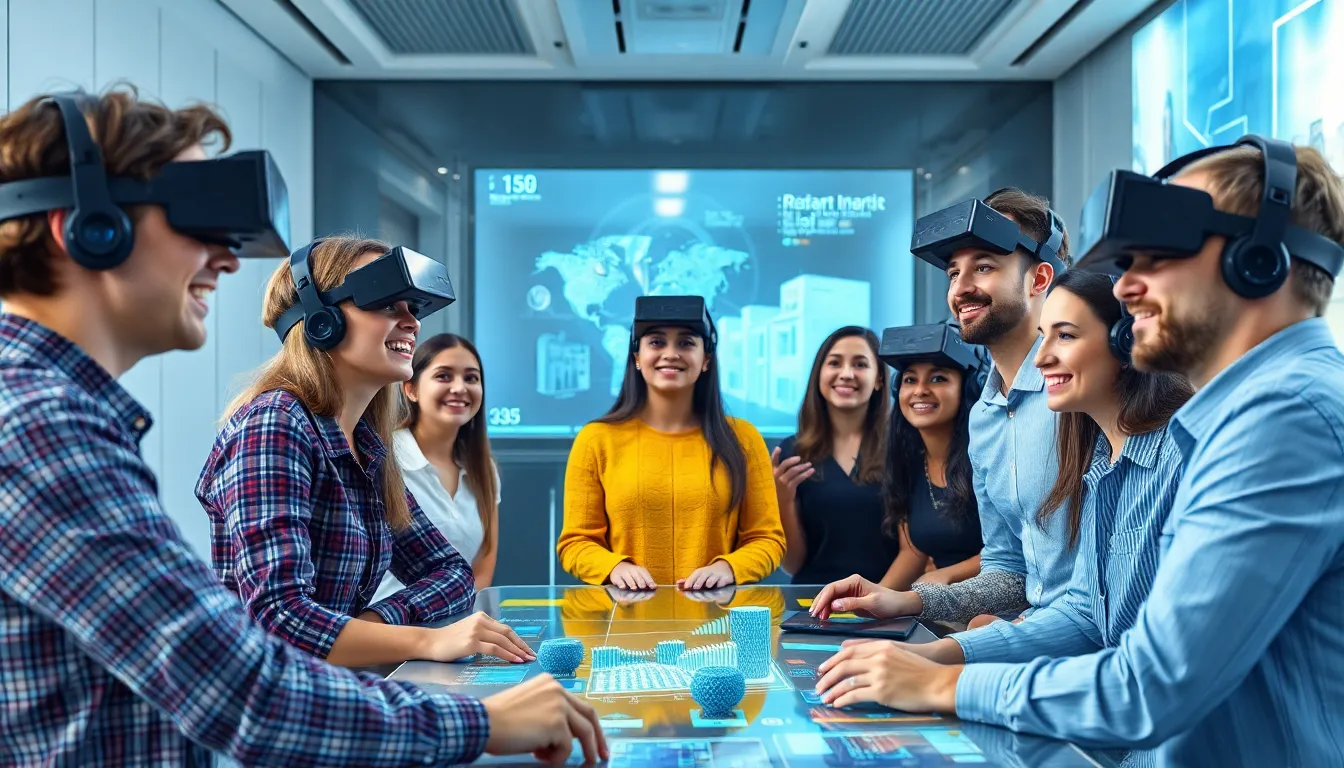Imagine attending a meeting where your colleague is halfway across the globe, yet it feels like they’re sitting right next to you. Welcome to the world of AR telepresence, where virtual reality meets reality, and distance becomes a mere afterthought. This cutting-edge technology isn’t just a sci-fi dream; it’s transforming how teams collaborate, socialize, and innovate.
Table of Contents
ToggleOverview of AR Telepresence
AR telepresence merges augmented reality with virtual communication, allowing people in different locations to interact as if they’re in the same space. Users experience life-like representations, enhancing collaboration and engagement levels during meetings. Visual tools elevate discussions, facilitating greater understanding of complex ideas.
Businesses benefit from AR telepresence by streamlining remote work. Teams coordinate more effectively across distances, addressing challenges in creativity and innovation. Reduced travel time and costs improve efficiency, making this technology economically viable for various industries.
Technological advancements underpin the effectiveness of AR telepresence. Software applications are designed to create realistic 3D holograms, providing users with customizable avatars. Integration with other communication tools enhances functionality, making seamless transitions between platforms possible.
Educational institutions utilize AR telepresence to foster interactive learning environments. Students engage in immersive lessons, experimenting with subjects in ways that traditional classrooms cannot replicate. This approach promotes active participation, leading to improved retention and understanding of material.
Research indicates that using AR telepresence can lead to increased satisfaction among remote workers. Sense of presence is significantly heightened, which contributes to a stronger connection among team members. As businesses embrace this technology, they open new avenues for growth and collaboration, transforming the future of work.
Benefits of AR Telepresence

AR telepresence offers significant advantages, enhancing collaboration and communication in remote environments.
Enhanced Communication
Improved communication becomes evident with AR telepresence. Participants interact with virtual avatars and 3D holograms that mimic real-life presence. This technology promotes clearer exchanges of ideas, breaking the barriers of traditional video conferencing. Active engagement from all attendees fosters dynamic discussions, ensuring that everyone contributes effectively. Issues around misinterpretation diminish as visual cues provide context in real time. Enhanced communication directly correlates with increased productivity, leading to more efficient problem-solving and decision-making processes among teams.
Immersive Experiences
Immersion defines the essence of AR telepresence. Users experience lifelike interactions, which significantly elevate involvement levels during meetings. The blend of real-world and digital elements creates a unique environment that stimulates creativity. Collaborators can visualize complex projects or concepts in ways that traditional methods cannot achieve. This enhanced visualization aids understanding and retention of information. Studies suggest that the immersive nature of AR telepresence boosts overall satisfaction among users, making remote collaboration feel more engaging and less isolating.
Applications of AR Telepresence
AR telepresence offers several impactful applications across various sectors, enhancing the way individuals connect, learn, and treat patients.
Remote Collaboration
Remote collaboration is significantly enhanced through AR telepresence. Teams can engage as though they’re physically together, despite being miles apart. This technology fosters real-time interactions, allowing participants to share ideas visually and reduce misunderstandings. Enhanced visual aids support discussions, yielding clearer communication and effective feedback. Companies report a marked increase in productivity when using AR tools, which streamline project management tasks. Overall, remote collaboration benefits from AR telepresence by fostering a sense of presence among team members, building stronger relationships, and encouraging innovative teamwork.
Education and Training
Education and training programs thrive with AR telepresence integration. Students immerse themselves in interactive lessons that feel dynamic and engaging. The ability to visualize complex concepts enhances comprehension, promoting active participation during instruction. Educators utilize AR applications to simulate real-world scenarios, allowing students to practice skills in a safe environment. Training sessions become more effective, as participants can learn in a hands-on manner. Research shows that this enriched learning experience leads to improved retention rates and a deeper understanding of material. Schools and institutions adopting AR telepresence observe a transformation in teaching methodologies.
Healthcare Solutions
Healthcare solutions gain considerable advantages through AR telepresence. Medical professionals can collaborate remotely, share visual information, and conduct virtual consultations. This technology allows healthcare providers to guide patients through procedures using interactive visuals, making complex instructions easier to follow. Surgeons may utilize AR to enhance their precision during operations, applying real-time imaging to navigate intricate anatomical structures. Telehealth applications streamline follow-up appointments, ensuring patients receive quality care without unnecessary travel. The result promotes efficient healthcare delivery, increases access for patients, and improves the overall standard of care.
Challenges and Limitations
AR telepresence faces several challenges and limitations that impact its widespread adoption. Evaluating these issues is essential for understanding the technology’s current landscape.
Technical Hurdles
Limited bandwidth often disrupts seamless communication in AR telepresence. High-quality visuals demand robust internet connections, which aren’t always available in all regions. Device compatibility remains another significant issue; not all devices can support advanced AR applications effectively. Moreover, users may encounter integration challenges when combining AR telepresence systems with existing communication infrastructure. Real-time data processing requirements also pose challenges, as insufficient processing power can lead to lag and reduced user experience. These technical hurdles influence the overall effectiveness of AR telepresence and its potential growth in various sectors.
User Adoption
User adoption presents a significant barrier to the growth of AR telepresence. Many individuals are unfamiliar with AR technology and may resist its implementation in their workflows. Training programs can help overcome this learning curve, but organizations must invest resources in adequate onboarding. Concerns related to privacy and security further complicate adoption. Users might hesitate to share sensitive information in virtual environments, fearing data breaches. Additionally, the perceived cost of implementing AR telepresence systems deters potential adopters. These factors contribute to slow acceptance rates, hindering the broader integration of AR telepresence in workplaces.
AR telepresence is reshaping the landscape of remote collaboration and communication. By creating immersive experiences that bridge the gap between physical distances, it enhances engagement and productivity. As businesses and educational institutions harness this technology, they unlock new possibilities for interaction and innovation.
While challenges such as technical limitations and user adoption persist, the potential benefits of AR telepresence are undeniable. Addressing these obstacles will be crucial for maximizing its impact across various sectors. As this technology continues to evolve, it promises to redefine how teams connect and collaborate in an increasingly digital world.









